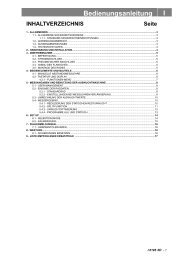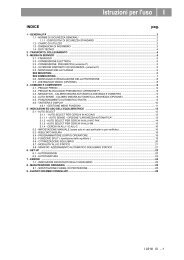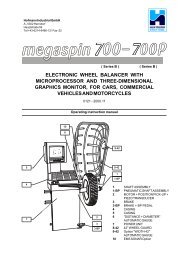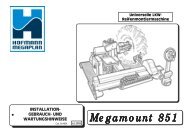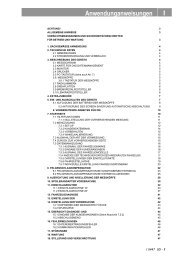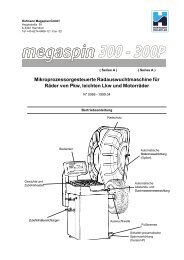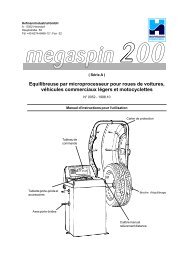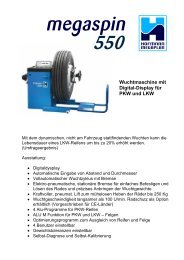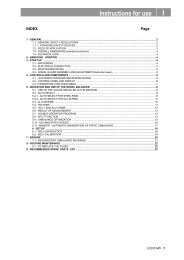Instructions for use I - Hofmann Megaplan
Instructions for use I - Hofmann Megaplan
Instructions for use I - Hofmann Megaplan
Create successful ePaper yourself
Turn your PDF publications into a flip-book with our unique Google optimized e-Paper software.
5.4.4 - ALU AND STATIC MODES<br />
From the Measurement screen, press button or to select the type required. The 5-LED<br />
displays show the position where to apply the weights. If a spin has already been per<strong>for</strong>med, the<br />
processor automatically recalculates, <strong>for</strong> each change of mode, the amounts of unbalance according to<br />
the new calculation.<br />
Fig. 16 Button → DYNAMIC → STATIC → DYNAMIC<br />
DYNAMIC<br />
Balancing of steel or light alloy rims with application of<br />
clip-on weights on the rim edges.<br />
STATIC<br />
Button<br />
ALU - 1<br />
The static mode is necessary <strong>for</strong> motorcycle wheels or<br />
when it is not possible to place the counterweights on<br />
both sides of the rim.<br />
→ ALU M → ALU 1→ ALU 2→ALU 3→ ALU 4→ ALU M<br />
Balancing of light alloy rims with application of adhesive<br />
weights on the rim shoulders.<br />
ALU - 2<br />
Balancing of light alloy rims with hidden application of the<br />
outer adhesive weight. Outer weight position is Þ xed.<br />
ALU - 3<br />
Combined application: clip-on weight inside and hidden<br />
adhesive weight on outside (Mercedes). Outer weight<br />
position is the same as ALU-2.<br />
ALU - 4<br />
Combined application: adhesive weight outside and<br />
clip-on weight inside.<br />
5.4.5 - AUTOMATIC ZEROING OF STATIC UNBALANCE<br />
Initial unbalance<br />
sx dx<br />
g g<br />
50°<br />
Possible approximation<br />
sx<br />
dx<br />
sx<br />
dx<br />
g g<br />
g g<br />
g g<br />
g<br />
static residual static residual static residual static residual<br />
With a traditional<br />
balancing machine<br />
sx<br />
4 g 3 g 1 g 6 g<br />
This program is designed to improve the quality of balancing without any mental ef<strong>for</strong>t or loss of time by<br />
the operator. In fact when using the normal commercially available weights, with pitch of 5 in every 5 g,<br />
and when applying the two counterweights which a conventional wheel balancer rounds to the nearest<br />
value, there could be a residual static unbalance of up to 4 g. The damage of such approximation is<br />
emphasized by the fact that static unbalance is ca<strong>use</strong> of most of disturbances on the vehicle. This new<br />
function automatically indicates the optimum entity of the weights to be applied by approximating them in<br />
an “intelligent” way according to their position in order to minimize residual static unbalance (theoretical<br />
zero). If it is not possible to completely zero the static unbalance with the dynamic unbalance kept in<br />
tolerance, such function supplies the solution <strong>for</strong> minimizing the static unbalance.<br />
dx<br />
Choice with minimum static<br />
residual<br />
sx<br />
dx<br />
g<br />
I 0162 GB - 17




